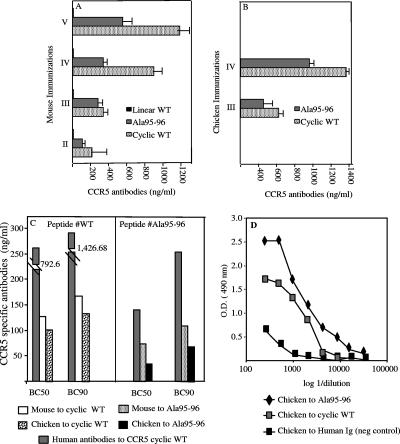FIG. 2.
Anti-CCR5 antibody titers induced in mice and chickens. (A) Mouse antiserum to Ala95-96 peptide in the cyclic conformation, its WT cyclic counterpart, and the native peptide in a linear conformation were analyzed by ELISA as described in Materials and Methods after the second, third, fourth, and fifth immunizations. Results show mean concentrations (in nanograms/milliliter) obtained in two assays performed; the top bars account for experimental variability. (B) Chickens were immunized with cyclic WT and Ala95-96 peptides at 3-week intervals. IgY antibodies were detected after the third and fourth immunizations by following the schedule presented in Materials and Methods. Chicken antibodies were tested at two concentrations (28 and 2.8 ng/ml). Results show mean values from two assays performed; the top bars account for experimental variability. (C) Human, mouse, and chicken CCR5-specific antibodies were quantified. Mouse antisera to cyclic WT and Ala95-96 peptides were tested after five immunizations. Chicken antibodies to cyclic WT and Ala95-96 peptides were tested after four immunizations. A pool of human sera from previously described (9) ESN having anti-CCR5 antibodies were tested for binding capacity on CCR5 cyclic WT and Ala95-96 peptides. Results are representative of the three assays performed. (D) Titration of anti-CCR5 chicken antibodies by ELISA as described in Materials and Methods. Chicken anti-human Ig was used as a negative control. Chicken antibodies were affinity purified as described in Materials and Methods and then quantified by ELISA. Chicken serum antibodies to Ala95-96 and to cyclic WT peptides were tested after four immunizations. Results are representative of the two independent assays performed.

